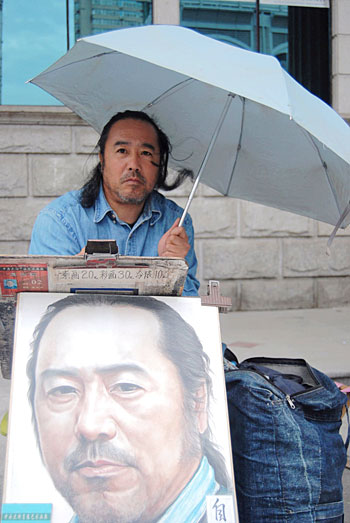|
 |
|
Song Dafang has gotten used to all kinds of weather in his 10-year career as a street portraitist (CHEN RAN) |
Hong Kong pop king Andy Lau, English soccer idol David Beckham, Taiwan R&B star Jay Chou... the black-and-white hand-painted portraits in A4 size unfolded on the street in two rows, with a rust-dotted iron easel standing right in the middle. A folding chair with a thick cushion on it sat behind the easel. Across from it was another folding chair with a cloth cover on it. A color hand-painted self-portrait in A3 size sat on the easel. The pony-tailed man in the portrait was in his fifties and had a heavy beard; his eyes were sharp and his wrinkly face looked solemn. A blue identity card on the bottom left read, "Song Dafang, Harbin Central Street Portrait Gallery, No. 7."
"They [The celebrity portraits] are very lifelike," a visitor said, standing in front of the portraits.
"Come on! Have your portrait done, just a couple of minutes," Song replied with a smile.
The visitor smiled and shook his head, walking away.
"Most visitors just take a look; very few actually sit for a portrait," Song sighed, crossing his arms. "I've gotten used to this over the years. It doesn't matter."
Believe it or not
Born in 1957 in Harbin, capital of northeast China's Heilongjiang Province, Song has been interested in drawing since childhood. Unfortunately, his parents considered his hobby "useless."
In the late 1950s, heavy industry played a vital role in the country's construction, particularly in Harbin, the national industrial base. Song's engineer father and accountant mother strongly believed in the old saying, "A promising career will only rely on excellence in mathematics, physics and chemistry."
"The cliché I most often heard in primary school was, 'You'll never make a living on fine arts,'" Song told Beijing Review.
Fortunately, Song's talent was discovered by his schoolteacher, who later recommended him for a drawing course at the local Youth Center. Song's parents began to support his "useless hobby" as they witnessed his striking progress with the help of professional guidance. Upon entering middle school in 1970, Song took charge of drawing blackboards and posters.
During the "Cultural Revolution" (1966-1976) in 1975, Song was sent to Ning'an Farmland in Mudanjiang City as an educated youth (zhiqing in Chinese). His talent in drawing helped free him from heavy farming work – instead, he continued the task he had begun in middle school. He even organized a personal painting exhibition. He then spent three years as a teacher at the farmland school, teaching Chinese, mathematics, fine arts and physical education; he even played the long-unused piano well, too.
| 
